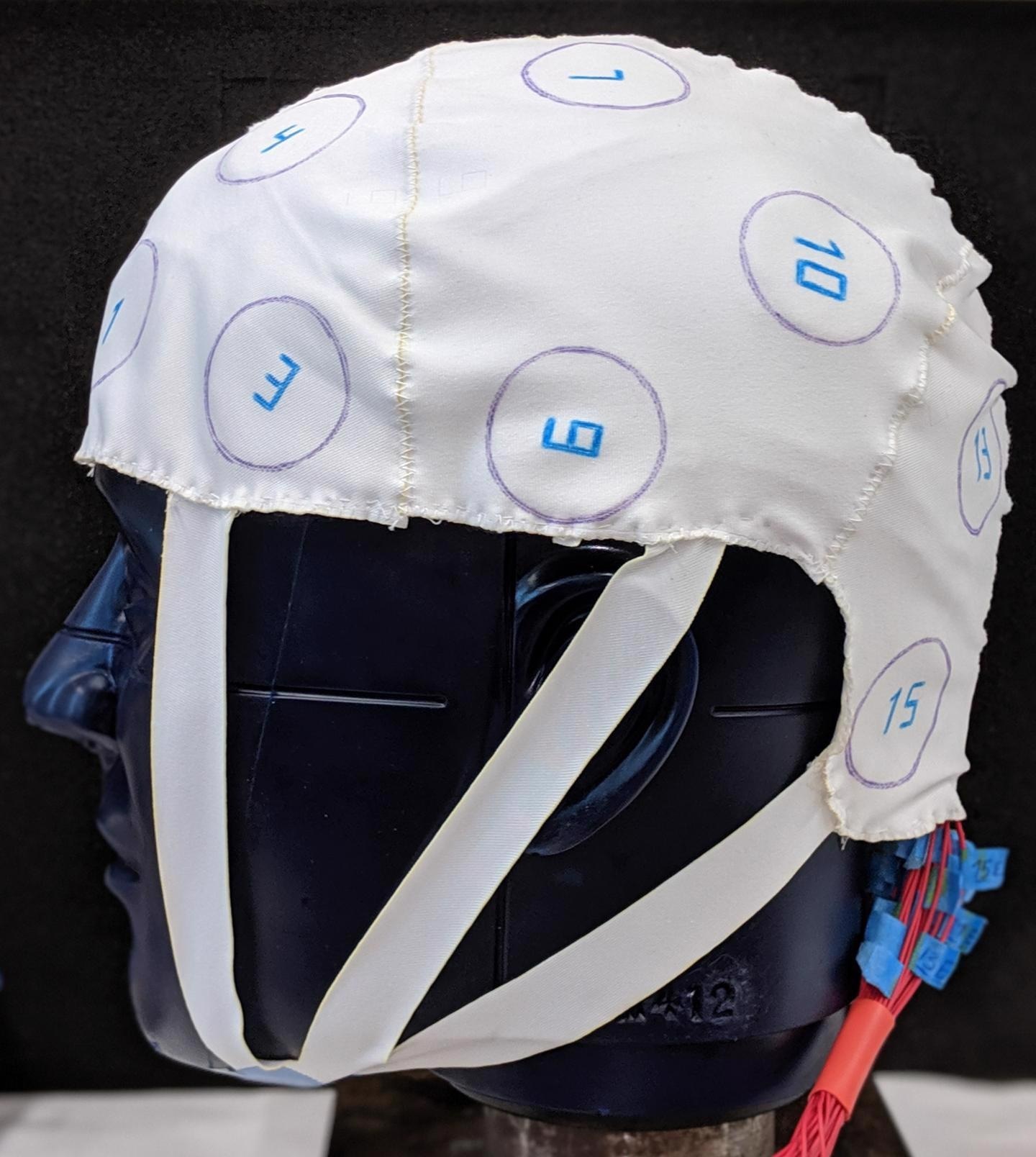 When worn under a helmet, a fit cap reveals the pressure exerted by the helmet on 16 different sensors. Adapted from ACS Sensors 2021, DOI: 10.1021/acssensors.0c02122.
When worn under a helmet, a fit cap reveals the pressure exerted by the helmet on 16 different sensors. Adapted from ACS Sensors 2021, DOI: 10.1021/acssensors.0c02122.
A new specially designed pressure-sensitive cap could help protect athletes from serious head injuries.
Head injuries have become a major concern for sports and athletics participants, and headgear that is designed to protect the wearer against such trauma could do more harm than good if it is loose or improperly fitted.
Currently, the fitting process of such headgear is somewhat subjective, done mostly by eye and feel, but a team of scientists from Western Michigan University has taken it upon themselves to tackle this situation head-on.
The team has designed a pressure-sensitive cap that can finally give wearers objective information about the fit of their protective headwear. Information that could potentially save them from severe injury or worse.
The cap contains pressure sensors and fits between the wearer's head and their helmet. The device is discussed in a paper published in the latest edition of the journal ACS Sensors¹.
Tackling the Problem Head-On
For the longest time, both concussions and traumatic brain injuries (TBIs) were a sad but accepted part of many sports and athletic events. But, over recent years our knowledge of the potential long-term effects of such injuries to the brain has grown exponentially.
This shift in attitude towards head injury can be seen most prevalently in American Football, where repeated blows have been shown to be a cause of chronic traumatic encephalopathy (CTE), a condition that can lead to degenerative brain disorders.
In 2017, a study¹ conducted by Boston University showed that 99% of NFL players tested suffered from CTE, and TBIs have become a leading cause of death and disability in the US.
Of course, protective equipment is available to athletes to help mitigate injuries caused by impacts to the head. Unfortunately, should such protective headgear become loose or be improperly fitted, wearers could be left exposed to the risk of head injury and not even be aware of it.
The Centre for Disease Control and Prevention estimates that sports-related injuries account for between 1.6 to 3.8 million TBIs per annum in the US alone. And data collected by the agency suggests that loose headgear could be playing a major role in these injuries, or perhaps more accurately, in not preventing these injuries.
Currently, there is no device commercially available that can give data on the fit of a helmet or other protective headwear. Thus it's hard to tell how well a helmet conforms to the shape of the wearer's head.
This could be about to change thanks to a team of researchers from Western Michigan University, including Simin Masihi and Massood Atashbar and their pressure sensor-equipped cap.
If the Helmet Fits
Fitting against the wearer's scalp and under their protective headgear, the cap designed by Masihi, Atashbar, and the team contains 16 pressure sensors, each of which is specifically aligned with a key area of the head.
Each one of these porous capacitive pressure sensors is made up of two fabric-based conductive electrodes and between them an insulating or dielectric material that is a poor conductor.
This sandwiched polydimethylsiloxane (PDMS) material is made porous by heating it and mixing it in its liquid state with nitric acid and sodium bicarbonate. This frees carbon dioxide and creates bubbles which, when the mixture cools and is trimmed, become pores.
This arrangement senses pressure when it is compressed because the PDMS material is squashed and the space between the two electrodes shrinks. This changes the capacitance between the electrodes, a change that is registered by a monitoring computer.
Ultimately, this allows the researchers to precisely measure the amount of pressure the helmet applies across distinct areas of the wearer's head. The team tested their cap with three volunteers and a single football helmet, finding it correctly indicated the pressure experienced by varying head sizes and shapes.
The team hopes that their pressure-sensitive cap can be used to assist athletes in picking a ready-made helmet off the shelf and companies to design safer custom-made headgear. In the process, this could help protect our sports and athletics stars from serious life-changing injuries.
References
1. Masihi. S., Panahi. M., Maddipatla. D., et al, [2021], 'Highly Sensitive Porous PDMS-Based Capacitive Pressure Sensors Fabricated on Fabric Platform for Wearable Applications,' ACS Sensors, [https://doi.org/10.1021/acssensors.0c02122]
2. Mez. J., Daneshvar. D. H., Kiernan. P. T., et al, [2017], 'Clinicopathological Evaluation of Chronic Traumatic Encephalopathy in Players of American Football,' JAMA, [doi:10.1001/jama.2017.8334]
Disclaimer: The views expressed here are those of the author expressed in their private capacity and do not necessarily represent the views of AZoM.com Limited T/A AZoNetwork the owner and operator of this website. This disclaimer forms part of the Terms and conditions of use of this website.